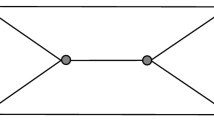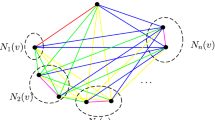Abstract
A strong edge-coloring of a graph G is an edge-coloring of G such that any two edges that are either adjacent to each other or adjacent to a common edge receive distinct colors. The strong chromatic index of G, denoted by \(\chi '_s(G)\), is the minimum number of colors needed to guarantee that G admits a strong edge-coloring. For any integer \(n\ge 3\), let \(H_n\) denote the n-prism (i.e., the Cartesian product \(C_n\square K_2\)) and \(H_n^{\Delta }\) the graph obtained from \(H_n\) by replacing each vertex with a triangle. Recently, Lin and Lin (2022) asked whether \(\chi '_s(H_n^{\Delta })=6\) for any \(n\ge 3\). In this short note, we answer this question in the affirmative.
Similar content being viewed by others
Avoid common mistakes on your manuscript.
1 Introduction
In this note, we only consider finite simple graphs. A strong k-edge-coloring of a graph G is a mapping \(\phi :E(G)\rightarrow \{1,2,\ldots ,k\}\) such that if any two edges e and f are either adjacent to each other or adjacent to a common edge in G, then \(\phi (e)\ne \phi (f)\). The strong chromatic index of G, denoted by \(\chi '_s(G)\), is the minimum integer k for which G has a strong k-edge-coloring. This concept was first introduced by Fouquet and Jolivet [8, 9] and was used to solve a problem involving radio networks and their frequencies (more details on this application can be found in [18, 19]).
A well-known conjecture of Erdős and Nešetřil [5, 6] states that for any graph G with maximum degree \(\Delta \), \(\chi '_s(G)\le \frac{5}{4}\Delta ^2\) if \(\Delta \) is even and \(\chi '_s(G)\le \frac{5}{4}\Delta ^2-\frac{1}{2}\Delta +\frac{1}{4}\) if \(\Delta \) is odd. This conjecture is still wide open. For graphs with \(\Delta \le 3\) (such graphs are often referred to as subcubic graphs), the conjecture was confirmed by Andersen [1], and independently by Horák, Qing and Trotter [11]. For graphs with \(\Delta =4\), an upper bound of 21 was proved by Huang, Santana and Yu [12] (note that the conjectured bound is 20). For sufficiently large \(\Delta \), Molloy and Reed [17] showed that \(\chi '_s(G)\le 1.998\Delta ^2\) by applying probabilistic techniques. This was later improved to \(1.93\Delta ^2\) by Bruhn and Joos [3], and then to \(1.835\Delta ^2\) by Bonamy, Perrett and Postle [2]. The current best known upper bound is \(1.772\Delta ^2\), which was recently derived by Hurley, de Joannis de Verclos and Kang [13].
The strong chromatic index of planar graphs has been intensively studied. Faudree et al. [7] proved that \(\chi '_s(G)\le 4\Delta +4\) for any planar graph G with maximum degree \(\Delta \), and showed that there exists a planar graph G with \(\chi '_s(G)= 4\Delta -4\) for any \(\Delta \ge 2\). Hocquard, Ochem and Valicov [10] proved that \(\chi '_s(G)\le 3\Delta -3\) for any outerplanar graph G with maximum degree \(\Delta \ge 3\), and constructed an example showing that the upper bound is the best possible. Confirming a conjecture of Faudree et al. [7], Kostochka et al. [14] proved that \(\chi '_s(G)\le 9\) for any subcubic planar graph G. For planar graphs with maximum degree 4, an upper bound of 19 was obtained by Wang et al. [20].
A graph is said to be claw-free if it does not contain an induced subgraph isomorphic to \(K_{1,3}\). Dȩbski, Junosza-Szaniawski and Śleszyńska-Nowak [4] showed that \(\chi '_s(G)\le \frac{9}{8}\Delta ^2+\Delta \) for any claw-free graph G with maximum degree \(\Delta \). This verified the aforementioned conjecture of Erdős and Nešetřil for claw-free graphs with maximum degree at least 12. For any integer \(n\ge 3\), the n-prism \(H_n\) is the Cartesian product \(C_n\square K_2\). In 2022, Lv, Li and Zhang [16] proved that \(\chi '_s(G)\le 8\) for any connected claw-free subcubic graph G other than the 3-prism, and asked whether the upper bound 8 can be improved to 7. Very recently, Lin and Lin [15] solved this problem and constructed infinitely many connected claw-free subcubic graphs with the strong chromatic index attaining the upper bound 7.
Theorem 1.1
(Lin and Lin [15]) If G is a connected claw-free subcubic graph not isomorphic to the 3-prism, then \(\chi '_s(G)\le 7\).
It is easy to observe that if G is a connected claw-free cubic graph, then \(\chi '_s(G)\ge 6\). Hence, Theorem 1.1 implies that \(\chi '_s(G)\in \{6,7\}\) for any connected claw-free cubic graph G other than the 3-prism.
Let \(H_n^{\Delta }\) denote the graph obtained from the n-prism \(H_n\) by replacing each vertex with a triangle. It is clear that \(H_n^{\Delta }\) is a connected claw-free cubic graph. At the end of their paper, Lin and Lin [15] suggested three questions for future research, one of which is as follows.
Question 1.2
(Lin and Lin [15]) Is it true that \(\chi '_s(H_n^{\Delta })=6\) for any integer \(n\ge 3\)?
The main objective of this short note is to give an affirmative answer to this question.
2 The proof
In this section, we prove the following theorem which answers Question 1.2 affirmatively.
Theorem 2.1
\(\chi '_s(H_n^{\Delta })=6\) for any integer \(n\ge 3\).
Proof For the sake of simplicity, suppose that \(V(H_n^{\Delta })=\{u_i,v_i,w_i,x_i,y_i,z_i:1\le i\le n\}\) and \(E(H_n^{\Delta })=\{u_iv_i,v_iu_{i+1},u_iw_i,v_iw_i,x_iy_i,y_ix_{i+1}, x_iz_i,y_iz_i,w_iz_i:1\le i\le n\}\), where the subscripts are taken modulo n. An illustration is depicted in Fig. .
As we mentioned in the Introduction, it is easy to observe that \(\chi '_s(H_n^{\Delta })\ge 6\). (One can notice that for each \(i=1,2,\ldots ,n\), the six edges incident to \(u_i,v_i\) or \(w_i\) must be colored with distinct colors.) Hence to prove Theorem 2.1, it suffices to show that \(H_n^{\Delta }\) admits a strong 6-edge-coloring which implies that \(\chi '_s(H_n^{\Delta })\le 6\). We consider two cases according to the parity of n.
Case 1 n is even.
Then \(n=2k\) for some integer \(k\ge 2\). We define an edge-coloring \(\phi \) of \(H_{2k}^{\Delta }\) as follows:
-
(1.1)
for each \(i=1,2,\ldots ,2k\), let \(\phi (u_iw_i)=1\), \(\phi (v_iw_i)=2\), \(\phi (x_iz_i)=3\) and \(\phi (y_iz_i)=4\);
-
(1.2)
for each \(i=1,3,\ldots ,2k-1\), let \(\phi (w_iz_i)=5\), \(\phi (u_iv_i)=\phi (x_iy_i)=6\), \(\phi (v_iu_{i+1})=3\) and \(\phi (y_ix_{i+1})=1\); and
-
(1.3)
for each \(i=2,4,\ldots ,2k\), let \(\phi (w_iz_i)=6\), \(\phi (u_iv_i)=\phi (x_iy_i)=5\), \(\phi (v_iu_{i+1})=4\) and \(\phi (y_ix_{i+1})=2\).
See Fig. for an illustration. It is easy to verify that \(\phi \) is a strong 6-edge-coloring of \(H_{2k}^{\Delta }\).
Case 2 n is odd.
If \(n=3\), then a strong 6-edge-coloring of \(H_3^{\Delta }\) is given in Fig. . So we may assume that \(n\ge 5\), and hence \(n=2k+1\) for some integer \(k\ge 2\). We define an edge-coloring \(\psi \) of \(H_{2k+1}^{\Delta }\) as follows:
-
(2.1)
for each \(i=1,2,\ldots ,2k+1\), let \(\psi (u_iw_i)=1\), \(\psi (v_iw_i)=2\), \(\psi (x_iz_i)=3\) and \(\psi (y_iz_i)=4\);
-
(2.2)
for each \(i=1,3,\ldots ,2k-1\), let \(\psi (w_iz_i)=5\), \(\psi (u_iv_i)=\psi (x_iy_i)=6\), \(\psi (v_iu_{i+1})=3\) and \(\psi (y_ix_{i+1})=1\);
-
(2.3)
for each \(i=2,4,\ldots ,2k-2\), let \(\psi (w_iz_i)=6\), \(\psi (u_iv_i)=\psi (x_iy_i)=5\), \(\psi (v_iu_{i+1})=4\) and \(\psi (y_ix_{i+1})=2\); and
-
(2.4)
for the remaining uncolored edges, let \(\psi (x_{2k+1}y_{2k+1})=1\), \(\psi (x_{2k}y_{2k})=\psi (y_{2k+1}x_1)=2\), \(\psi (u_{2k+1}v_{2k+1})=3\), \(\psi (u_{2k}v_{2k})=\psi (v_{2k+1}u_1)=4\), \(\psi (w_{2k}z_{2k})=\psi (w_{2k+1}z_{2k+1})=5\), and \(\psi (v_{2k}u_{2k+1})=\psi (y_{2k}x_{2k+1})=6\).
Please refer to Fig. for a detailed illustration. One can easily check that \(\psi \) is a strong 6-edge-coloring of \(H_{2k+1}^{\Delta }\). This completes the proof of the theorem. \(\square \)
References
Andersen, L.D.: The strong chromatic index of a cubic graph is at most \(10\). Discrete Math. 108, 231–252 (1992)
Bonamy, M., Perrett, T., Postle, L.: Colouring graphs with sparse neighbourhoods: bounds and applications. J. Combin. Theory Ser. B 155, 278–317 (2022)
Bruhn, H., Joos, F.: A stronger bound for the strong chromatic index. Combin. Probab. Comput. 27, 21–43 (2018)
Dȩbski, M., Junosza-Szaniawski, K., Śleszyńska-Nowak, M.: Strong chromatic index of \(K_{1, t}\)-free graphs. Discrete Appl. Math. 284, 53–60 (2020)
Erdős, P.: Problems and results in combinatorial analysis and graph theory. Discrete Math. 72, 81–92 (1988)
Erdős, P., Nešetřil, J.: Problem. In: Halász, G., Sós, V.T. (eds.) Irregularities of Partitions, pp. 162–163. Springer, Berlin (1989)
Faudree, R.J., Schelp, R.H., Gyárfás, A., Tuza, Z.: The strong chromatic index of graphs. Ars Combin. 29, 205–211 (1990)
Fouquet, J.L., Jolivet, J.L.: Strong edge-colorings of graphs and applications to multi-\(k\)-gons. Ars Combin. 16, 141–150 (1983)
Fouquet, J.L., Jolivet, J.L.: Strong edge-coloring of cubic planar graphs. In: Progress in Graph Theory. (Waterloo, 1982), pp. 247–264. Academic Press, Toronto (1984)
Hocquard, H., Ochem, P., Valicov, P.: Strong edge-colouring and induced matchings. Inform. Process. Lett. 113, 836–843 (2013)
Horák, P., Qing, H., Trotter, W.T.: Induced matchings in cubic graphs. J. Graph Theory 17, 151–160 (1993)
Huang, M., Santana, M., Yu, G.: Strong chromatic index of graphs with maximum degree four. Electron. J. Combin. 25, \(\#\)P3.31 (2018)
Hurley, E., de Joannis de Verclos, R., Kang, R.J.: An improved procedure for colouring graphs of bounded local density. Adv. Combin. 7 (2022)
Kostochka, A.V., Li, X., Ruksasakchai, W., Santana, M., Wang, T., Yu, G.: Strong chromatic index of subcubic planar multigraphs. Eur. J. Combin. 51, 380–397 (2016)
Lin, Y., Lin, W.: The tight bound for the strong chromatic indices of claw-free subcubic graphs. arXiv preprint (2022) arXiv:2207.10264
Lv, J.-B., Li, J., Zhang, X.: On strong edge-coloring of claw-free subcubic graphs. Graphs Combin. 38, 63 (2022)
Molloy, M., Reed, B.: A bound on the strong chromatic index of a graph. J. Combin. Theory Ser. B 69, 103–109 (1997)
Nandagopal, T., Kim, T.-E., Gao, X., Bharghavan, V.: Achieving MAC layer fairness in wireless packet networks, in: Proceedings of the 6th Annual International Conference on Mobile Computing and Networking, pp 87–98. (2000)
Ramanathan, S.: A unified framework and algorithm for (T/F/C)DMA channel assignment in wireless networks, in: Proceedings of the INFOCOM’97, pp 900–907. (1997)
Wang, Y., Shiu, W.C., Wang, W., Chen, M.: Planar graphs with maximum degree \(4\) are strongly \(19\)-edge-colorable. Discrete Math. 341, 1629–1635 (2018)
Acknowledgements
This work was partially supported by the National Natural Science Foundation of China (No. 12171239).
Author information
Authors and Affiliations
Corresponding author
Ethics declarations
Conflict of interest
The authors declare that they have no conflict of interest.
Additional information
Publisher's Note
Springer Nature remains neutral with regard to jurisdictional claims in published maps and institutional affiliations.
Rights and permissions
Springer Nature or its licensor (e.g. a society or other partner) holds exclusive rights to this article under a publishing agreement with the author(s) or other rightsholder(s); author self-archiving of the accepted manuscript version of this article is solely governed by the terms of such publishing agreement and applicable law.
About this article
Cite this article
Han, Z., Cui, Q. A note on strong edge-coloring of claw-free cubic graphs. J. Appl. Math. Comput. 69, 2503–2508 (2023). https://doi.org/10.1007/s12190-023-01847-x
Received:
Revised:
Accepted:
Published:
Issue Date:
DOI: https://doi.org/10.1007/s12190-023-01847-x








